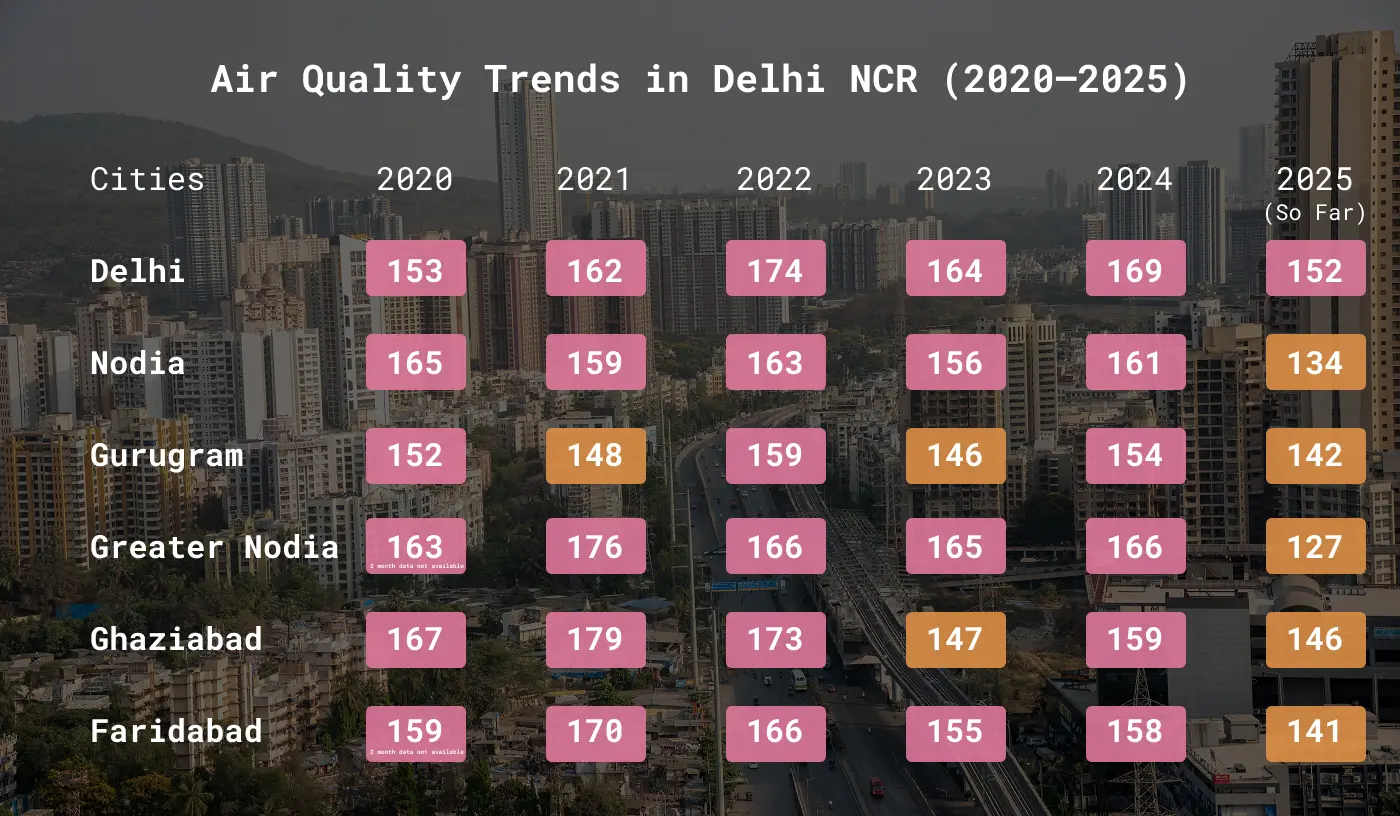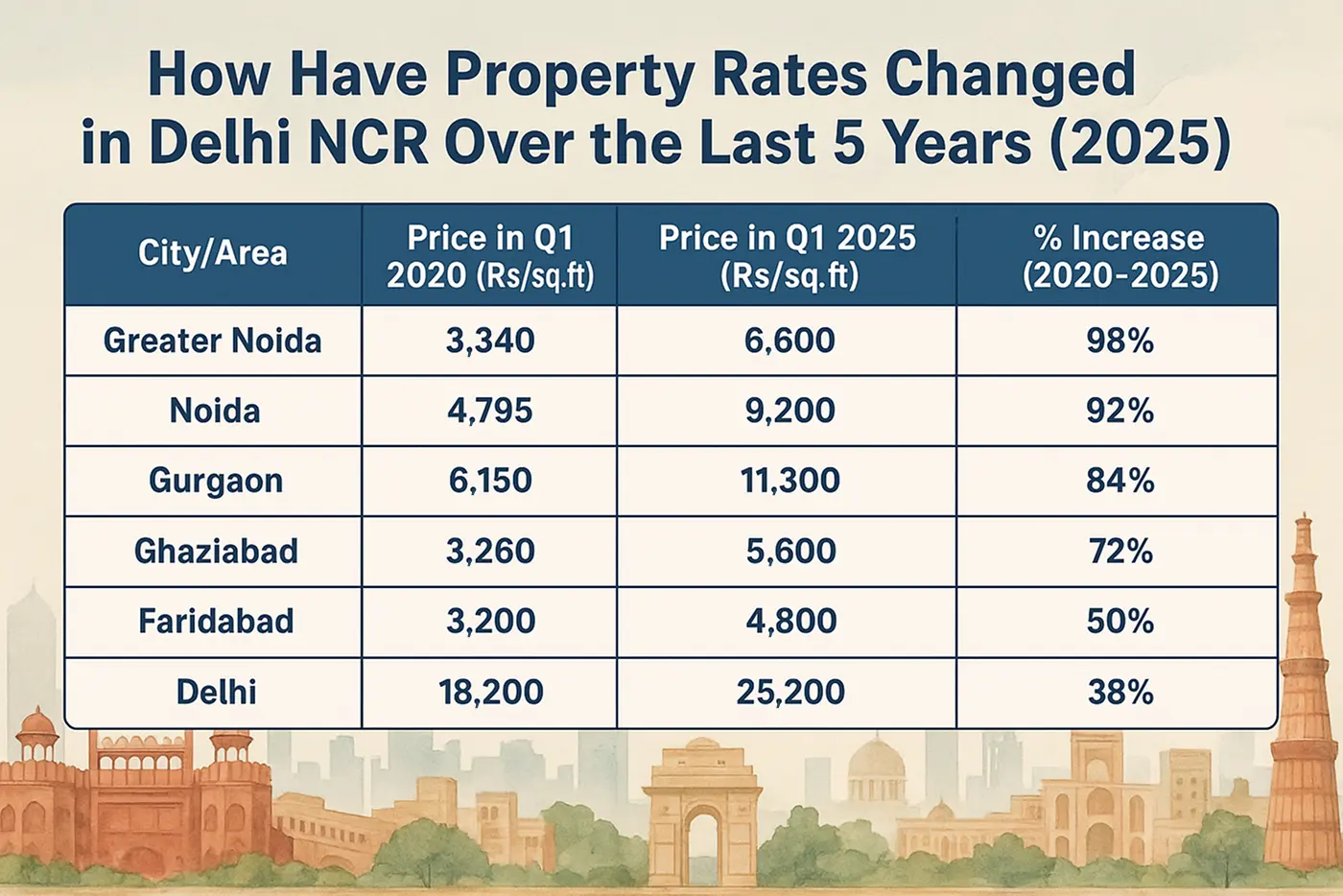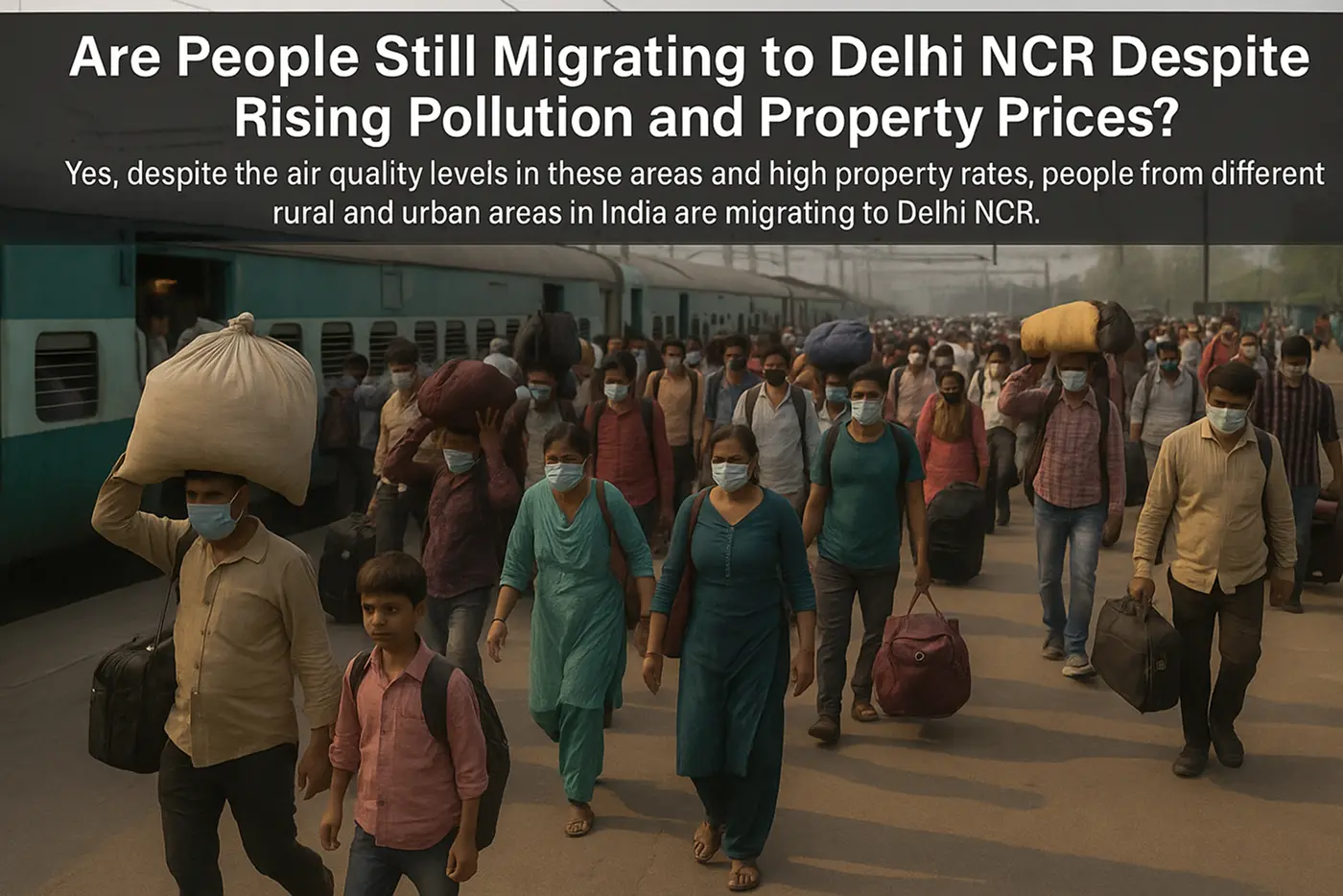In today’s world, capital cities in developing countries, like Delhi, fascinate everyone. You might dream of settling in Delhi NCR for better growth, more opportunities, and a brighter future for your children. And of course, you want the safest, healthiest environment possible as modern skyscrapers and shiny malls spring up all around you. But do people really consider air pollution before moving to Delhi NCR?
Every year, families from small towns pack up and head to Delhi, Gurugram, Noida, Greater Noida, Faridabad, and Ghaziabad. Yet the question remains: are we aware of how many years of healthy life we might be sacrificing the moment we step into these fume‑filled skies? In the dream of a clearer tomorrow, are we willingly ready to trade our future and years of life expectancy?
To answer this, I’ve gathered five years of historical data—year‑on‑year air‑quality levels alongside migration, construction, and property‑rate trends across the six NCR hubs. To answer this question shortly, yes, people are still migrating to Delhi NCR, and property rates and living standards are climbing. But hidden beneath the gleaming dreams, air pollution is rising too and affecting millions each year.
What’s Included in This Blog, and Why Does It Matter?
This blog includes the possible data of air quality, migration, and property rates in Delhi NCR, focusing on the cities of Gurgaon, Delhi, Noida, Greater Noida, Faridabad, and Ghaziabad, over the last five years (2020-2024). The only purpose of this blog is to understand do people really consider air pollution before moving to Delhi NCR? Or do Property rates really affect by the location’s air quality? Here are the points to understand and get the answers to all your questions.
What Are the Air Quality Trends in Delhi NCR (2020–2025)?
Air pollution in Delhi NCR is well known for its air pollution, as it has a long history of becoming the most polluted cities in the world. Not just this, Delhi NCR is also known for the dangerously polluted areas in India. To know the actual situation and trends, here is the annual average of historical AQI data of Delhi NCR’s top 6 cities:

As per this data by AQI.in, you can see their no effective decline in air quality in the last 5 years. Because what AQI recorded in 2020, the same numbers have been recorded in 2024 as well, even higher in some locations. It means air pollution always remains a concern in the Delhi NCR. To determine if people consider AQI before migrating and purchasing their homes, we need to examine property rates and migration data.
For other NCR cities, historical data is less accessible through public sources. Reports from AQI.in and other environmental agencies suggest that cities like Gurgaon, Noida, Greater Noida, Faridabad, and Ghaziabad experience similar pollution levels, with PM2.5 concentrations often exceeding WHO annual guidelines (5 µg/m³).
How Have Property Rates Changed in Delhi NCR Over the Last 5 Years (2020–2025)?
Owning your house in Delhi NCR cities is the dream of many people. But due to know how costly it is becoming to buy lands and properties in these cities? To understand the change in the cost of property in Delhi NCR areas, here is the past 5 years’ data collected from a news source reported in 2025. The following table details the percentage increase in property prices from Q1 2020 to Q1 2025, based on a recent news article:

| City/Area | Price in Q1 2020 (Rs/sq.ft) | Price in Q1 2025 (Rs/sq.ft) | % Increase (2020-2025) |
| Greater Noida | 3,340 | 6,600 | 98% |
| Noida | 4,795 | 9,200 | 92% |
| Gurgaon | 6,150 | 11,300 | 84% |
| Ghaziabad | 3,260 | 5,600 | 72% |
| Faridabad | 3,200 | 4,800 | 50% |
| Delhi | 18,200 | 25,200 | 38% |
Some more findings and observations on Property Rates changes in Delhi NCR:
- Specific micro-markets also show significant appreciation. For example, Greater Noida West (Noida Extension) saw a 24% increase in the last year, reaching 8,450 Rs/sq.ft by end-2024, while Dwarka Expressway more than doubled since 2019, currently at 11,000 Rs/sq.ft. Sohna Road experienced a 59% capital value increase from 2021-end to 2024-end, now at 6,000 Rs/sq.ft.
- Luxury housing demand has surged, with 59% of new launches in 2024 priced above Rs 2.5 crore, indicating a preference for premium living spaces despite pollution.
- The evidence leans toward migration to Delhi NCR continuing to be strong, driven by economic opportunities, with over 200,000 people migrating annually in recent years.
- It appears that construction activity has been robust, with thousands of new residential units launched each year, indicating sustained development.
Are People Still Migrating to Delhi NCR Despite Rising Pollution and Property Prices?
Yes, despite the air quality levels in these areas and high property rates, people from different rural and urban areas in India are migrating to Delhi NCR. Delhi NCR has become the migration magnet for Indians because of different factors and opportunities. First of all, being the capital city, better opportunities for growth, education for children, and more employment are the key attractions for migrants. Here are some trends and key data points to know about the migration in Delhi NCR:

- 2021: 283,000 people migrated to Delhi, more than double the natural population growth of 101,000.
- 2022: 221,000 people migrated to Delhi.
- Historical census data (2011) shows 7,224,514 migrants, but recent annual figures indicate continued high inflows, with Delhi having the highest share of inter-state migrants in India.
Has Construction Activity Increased in Delhi NCR Over the Past 5 Years?
If we check the number of construction activities in Delhi NCR, it helps in indicating if people are really aware of the air quality they are breathing. Because the number of construction activities signifies that these regions’ real estate is blooming. Not just this, if you see the major developments in areas like Gurugram and Greater Noida, these areas have bloomed in the last ten to five years. Hence, all thanks to advanced construction and development in these areas.

Residential Launches & Absorption
- 2024 saw a 44% jump in new realty launches across NCR compared to 2023, with 23,500 units launched in H1 2024 versus 22,707 in H1 2023.
- Luxury segment boomed, making up 64% of new launches; Gurugram accounted for 55%, Noida for 35%.
- Overall, Delhi NCR’s housing supply outpaced other Tier-1 cities in 2024, with absorption rising ~5% YoY since 2020
Signature Infrastructure Projects
- Delhi–Meerut RRTS: First 17 km operational by Oct 2023; extended 55 km corridor active by January 2025.
- DND–KMP Expressway: A 59 km corridor connecting Delhi, Faridabad, and Jewar Airport—segments opened from Feb 2023 to Nov 2024; full project completion expected by mid‑2025.
- Ghaziabad–Jewar RRTS: DPR and survey completed by early 2024; awaiting approvals and construction to begin.
- Haryana Orbital Rail Corridor: DPR for Eastern corridor (90 km) approved Feb 2025; will link Ghaziabad, Noida, Greater Noida, Faridabad
The world wants to know: Do People Really Consider Air Pollution Before Moving to Delhi NCR?
The data tells a different story. Over the past five years, trends in construction, migration, and property rates reveal another side of awareness. Opportunities, growth, and the pursuit of a better life seem to matter more than the health of the individual, because people aren’t truly concerned about the air they’re breathing. It clearly highlights the lack of awareness among people in India about the quality of the air they breathe. Awareness about air quality in Delhi NCR remains generally low, especially among certain demographics.
- A 2020 survey by the Lung Care Foundation found 92% of respondents unaware of the difference between PM2.5 and PM10, and 78.1% unaware of government initiatives.
- A 2024 survey by Chintan Environmental Research and Action Group showed only 10% awareness among the urban poor of terms like AQI and PM2.5, compared to 71% among middle-class residents.
- Government efforts like the Graded Response Action Plan (GRAP) exist, but awareness remains limited, especially among marginalized groups.
Conclusion
Hence, all the points mentioned above highlight that air quality awareness is still in the shadows. Despite being among the most polluted cities in the world, people aren’t really concerned about their health or the well-being of their loved ones. Air quality still doesn’t hold any significant influence in Delhi NCR when it comes to property rates, construction, or migration.
Every year, a new report comes out. Every year, seasonal changes flood the news with air pollution headlines. And every year, Diwali cracker bans become the centre of attention. And yet, air quality remains a non-issue for those living in or migrating to Delhi NCR.
The low level of awareness, especially among the urban poor, could explain why air quality isn’t a major deciding factor. Maybe, as awareness grows, the trend will shift. But for now, economic opportunities take the front seat over environmental health.